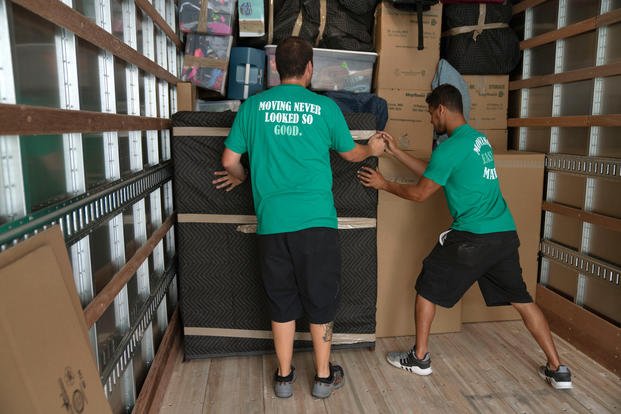The Personally Procured Move (PPM), formerly known as a do-it-yourself, or DITY, move, allows military members to be reimbursed for up to 100% of what your moving job would have cost the government.
You're eligible for the PPM moving reimbursement program if you make a Permanent Change of Station (PCS), Temporary Duty (TDY) or Temporary Additional Duty (TAD) move. You're also eligible if you separate, retire or move to or from government quarters under orders.
The program is voluntary, and you can use the entire PPM program or just part of it. For example, you can ship some household goods on a Government Bill of Lading (GBL) and then use the PPM program for the balance, up to the allowed weight allowance.
You may use your own vehicle, a rental or a borrowed vehicle. You're entitled to travel allowances, per diem and mileage through the government. An advance monetary allowance for your move can be paid under certain circumstances. Since benefits and how they are processed are handled differently by each military service, you'll need to see your transportation office representative for details on how to use them.
Ways to Do a Personally Procured Move (PPM)
Upon receiving permanent change of station orders, service members and their families are entitled to make PPMs using a variety of resources, including a rental truck or trailer; a commercial moving van service; pod container and moving services; or their own vehicle.
Remember: Only after applying for and being authorized for a PPM can you proceed with the move. If you make a partial PPM (i.e., only shipping a certain amount of household goods), make sure you work out all the details with your representative. Note that you will not receive full government payment for your PPM until after your move.
Here are several types of PPMs and tools to consider:
Partial Personally Procured Move (PPM)
This is the most common type of PPM, and it means you are paid to move a portion of your own household goods, typically in your own vehicle or in a trailer you rent or own. You must work out the details of this move with your service transportation office. Just like in a full PPM, you must weigh your vehicle both empty and full, as described in the steps below. You will be reimbursed for your partial PPM after you submit all of your receipts and paperwork after your move.
Full Personally Procured Move (PPM)
In this type of PPM move, you are fully in charge of your own move, including all of your household goods. Here are three ways to make this happen:
- Rental trucks and equipment: You rent a truck or trailer, and receive an advance operating allowance based on mileage authorized and estimated weight of shipment. There is no advance on separation orders. You're responsible for packing, loading, driving, unloading and unpacking the shipment. Storage at destination is at your expense, with reimbursement.
- You load/they drive: You pack and load a commercial moving van/truck, the commercial moving company drives to the destination, and you unload and unpack the van or truck. The commercial firm must provide you with an MC number, and state or federal regulation numbers. You must request that the company provide weight tickets.
- Privately Owned Vehicle (POV) PPM: No advance operating allowance on a POV PPM is authorized. You may use your own or a borrowed vehicle. If you borrow the vehicle, you must have written permission from the vehicle owner for all POV PPMs. Current vehicle registration is also required. The POV must be a "cargo"-type vehicle, not a vehicle that is designed for passenger transport.
Moving a Mobile Home
The government will pay to move your mobile home as your military move instead of a normal household goods shipment. Mobile home moves, known as a Government Arranged Home Shipment, are only authorized for CONUS (continental U.S.) to CONUS and to and from Alaska. While the government will pay to move your home with household goods inside of it, it advises that you review the moving weight information for your home before you ship it full of belongings. You also must remove heavy items like freezers and pianos. Read more about mobile home shipping.
Why You Should Do a Personally Procured Move
At first glance, the PPM program may seem more trouble than it's worth. After all, you have to take care of your own moving arrangements and expenses, rather than have the government do it for you. For some, keeping track of receipts is a major hassle in itself.
Related: Can You Make Money Off a PPM?
But if you do a little planning and put forth a bit of effort, doing a PPM can have significant advantages over a normal military move. For example:
- Money. If you do a PPM, you receive a payment equal to what it would cost the government to move you. In addition, you receive standard travel allowances for you and your family. If you spend less than the payment the government provides, you get to keep the balance. If you take advantage of moving company discounts and other special offers, you might find yourself with cash left over, perhaps up to several thousand dollars. You especially should consider a PPM if you have a limited amount of items that need shipping or moving; you may be able to take care of the packing and transport yourself.
- Time. When you receive orders to move to another area, you're authorized permissive TDY or travel time in order to take care of your moving arrangements. With PPM, you'll receive additional time to handle your move -- time that you can use to relax if you're efficient about planning your move.
- More control. While it's nice to do without the headaches of planning a move, many military personnel had less than ideal experiences when the government took care of their moves. With PPM, you're in control every step of the way, from deciding which moving services you want to how much of the actual move you want to handle yourself.
Related: How to find military move discounts
8 Steps to a Smooth Personally Procured Move
To take advantage of the PPM program, follow each of the steps outlined below:
1. Apply for the PPM by scheduling an appointment with your base's PPO office. They will walk you through the program and give you all the forms and instructions you need. While each service has a slightly different process for arranging a move, the forms likely include:
- DD Form 2278: Application for Move and Counseling Checklist
- Certified empty weight ticket for each shipment with your name and signature of weight master
- Certified loaded weight ticket for each shipment with your name and signature of weight master
- Original DD Form 1351-2: Travel voucher or subvoucher
- Copy of registration for your boat(s) and/or trailer(s), if applicable
You can find all PCS-related reimbursement forms on the Defense Finance and Accounting Service (DFAS) website.
2. Decide on your type of move. Will you be doing this all yourself? Will you have packers help? Will you have a moving company take care of the actual transport? Nail down these arrangements as soon as possible.
3. Arrange for any rental equipment or moving services you need. You can either do it all yourself, have a professional handle tasks or some of both. Packing materials can be purchased from commercial suppliers.
4. Confirm your insurance coverage. Make sure you are up to date on your car and accident insurance. If you use a trailer, check your auto insurance policy to make sure you're covered. State laws regarding liability for accidents during a PPM vary, so if you're involved in an accident while performing a PPM, you should contact the legal office at the military installation nearest the accident site as soon as possible.
5. Confirm any advanced operating allowance from your military service and rules surrounding your use of the Government Travel Charge Card (GTCC) Program.
6. When your vehicle (whether you own it or are renting) is ready, calculate the total weight of what you are moving. You or your hired moving company should weigh your vehicle both fully loaded and unloaded. This is extremely important, as your PPM payment will be based on this weight ticket. To calculate the weight of your shipment, follow this formula:
- Empty weight = your vehicle with a full tank of gas, but with no drivers or passengers inside
- Loaded weight = your vehicle with a full tank of gas + all of your property loaded, but still with no drivers or passengers inside
- Loaded weight - empty weight = net weight of property
Confirm what information you need on your weight tickets. That information could include:
- Name, grade
- Name/location of scale
- Vehicle/trailer identification
- Date of weighing
- Weighmaster's signature
- Legible imprint of weight
7. Get receipts for all moving expenses. All costs associated with the move are not taxable, and they will be deducted from the allowance you receive from the move to determine your profit. Only your profit will be taxed, so be sure to keep track of everything to maximize your profit. Authorized expenses include:
- Rental truck/trailer
- Rental (not purchase) of moving equipment, such as hand trucks and dollies
- Furniture pads and tie-downs
- Boxes/tape and packing material
- Hired labor
- Travel allowances under certain circumstances
- Gas and oil expense (but not an oil change)
- Highway tolls, weight tickets and any other transportation expense directly related to the PPM
8. Make your move and submit your settlement. Once you complete your actual move, you have 45 days to submit a claim for full payment of your PPM allowance. Confirm details on what you need to submit with your transportation office, but it could include the following:
- Empty and loaded weight tickets (two copies of each)
- DD Form 2278
- PPM move certification (attach all receipts for moving expenses)
- PPM move expense sheet
- PCS orders
- Advance operating allowance paperwork (if authorized)
- Vehicle/trailer rental contract (if you are renting a truck or trailer)
- Any other paperwork as advised by your PPO
Whether you're facing a PCS move in the near future, or just thinking back on how you would do your last move differently, be sure to consider the option of a PPM where you don't do it all yourself.
To get more PCS tips or information, visit the Military.com PCS center.
Keep Up-to-Date for Your Next PCS
Get the inside information from those who know. Get PCS help and all the news and benefits information you need delivered straight to your inbox. Sign up for a free membership today.














